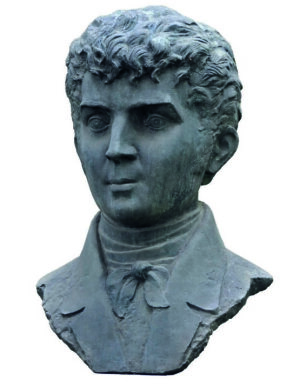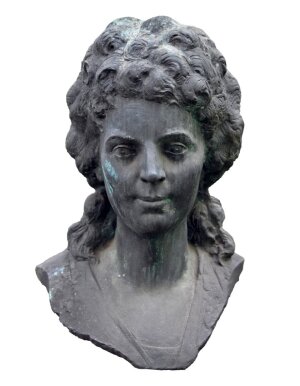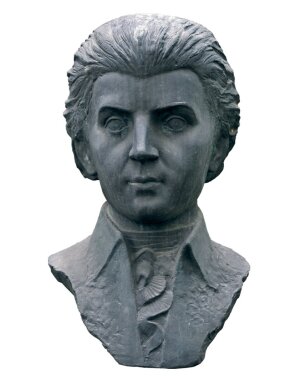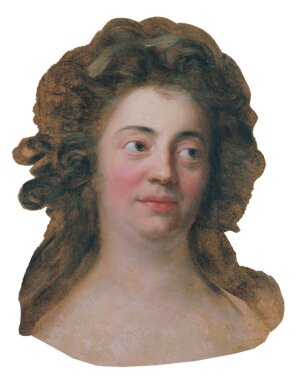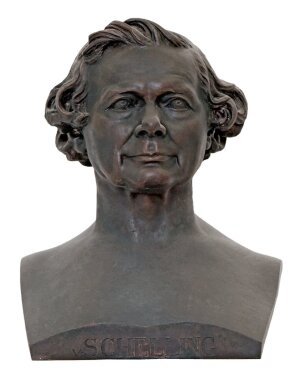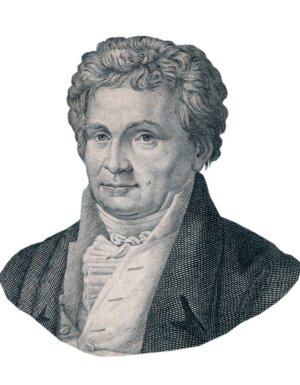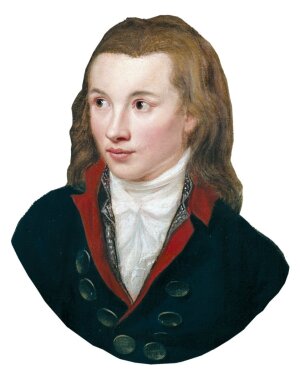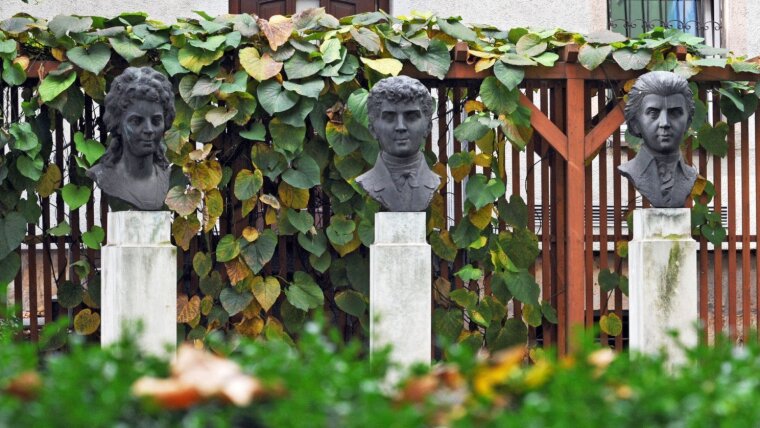
August Wilhelm Schlegel
Image: Anne Günther (University of Jena)August Wilhelm Schlegel
(1767–1845)
After spending his formative years in Hannover, Schlegel began his studies in Göttingen in 1786, where he first studied theology before switching his focus to classic philology. After completing his studies in 1791, he moved to Amsterdam to work as a private tutor and pursued literary studies. His essay on »Dante’s Inferno« garnered high praise from Schiller, who suggested that he come to Jena, which Schlegel did in 1796 shortly after his marriage to Caroline Böhmer. When in Jena, he worked on translations of the works of Shakespeare, publishing no fewer than 17 translated dramas between 1797 and 1810. From 1798 to 1800, he and his brother Friedrich published the journal called »Athenaeum«, the mouthpiece of Early Romanticism. In 1798, he was appointed as an adjunct professor at the University of Jena, where he gave a series of lectures on topics such as »Philosophical Art Theory«. In 1801, he settled in Berlin as a private scholar. In 1803 his marriage to Caroline was divorced.
Caroline Schelling
Image: Anne Günther (University of Jena)Caroline Schelling
(née Michaelis, wid. Böhmer, div. Schlegel)
(1763–1809)
As the daughter of a scholar from the University of Göttingen, Caroline was introduced to literature at an early age. In 1784, she was married to the doctor Franz Böhmer and moved with him to Clausthal in the Harz region. Her daughter Auguste was born in 1785. By 1788, she had given birth to another daughter and a son, both of whom died as infants. Her husband also died in 1788. After moving to Mainz in 1792, Caroline witnessed the birth of the »Republic of Mainz«. She supported their revolutionary democratic ideas. In 1793, she became pregnant with the baby of a French lieutenant. As the Prussian forces moved in on Mainz, Caroline attempted to flee the city but was captured and imprisoned for several months due to her alleged ties to the Jacobins. After being released from prison, she gave birth to her fourth child, a son. He also died before the age of two. She married August Wilhelm Schlegel in 1796 and moved with him to Jena, where she helped her husband to translate the works of Shakespeare as a central figure within the home shared by the Romantic pioneers at Leutragasse 5. In 1803 her marriage was divorced and Caroline married Friedrich Joseph Wilhelm Schelling.
Friedrich Schlegel
Image: Anne Günther (University of Jena)Friedrich Schlegel
(1772–1829)
Just like his older brother August Wilhelm, Friedrich Schlegel grew up in Hannover and started studying in 1791, first in Göttingen and then in Leipzig. His studies included law, philosophy, classical philology and history. In 1794, he moved to Dresden to work as a freelance writer. He joined his brother in Jena in 1796. In 1797, he met the theologian Friedrich Schleiermacher and the author Ludwig Tieck, as well as his future wife Dorothea Veit. With Novalis, whom he had known since his student days in Leipzig, he developed a Romantic art form known as »fragments« in the journal »Athenaeum«. He rose to prominence with his 116th Athenaeum fragment, in which Schlegel described the Romantic poetic agenda as »progressive universal poetry«. Schlegel habilitated at the University of Jena in 1800 and continued teaching there as a private lecturer. In 1801, he left Jena and moved back to Dresden with Ludwig Tieck.
Dorothea Schlegel
Image: bpk / Nationalgalerie, SMBDorothea Schlegel
(née Mendelssohn, div. Veit)
(1763–1839)
The daughter of the Jewish enlightener and philosopher Moses Mendelssohn grew up in the intellectual centre of Berlin. Her parents’ home was frequented by the likes of Friedrich Nicolai, Gotthold Ephraim Lessing and Friedrich Gottlieb Klopstock. Dorothea married the banker Simon Veit in 1783 and gave birth to four sons, two of whom two survived. Her salon, which she ran with her friend (the writer Henriette Herz), was visited by the likes of Alexander and Wilhelm von Humboldt, Ludwig Tieck and Friedrich Schleiermacher. That’s where Dorothea met Friedrich Schlegel in 1797 and the two became lovers—despite the fact he was nine years her junior. One year later, she left her husband and moved with Schlegel to Jena. She divorced in 1799. She converted to Protestantism in 1804 before turning to the Catholic faith with Friedrich Schlegel in 1808 and marrying him.
Friedrich Wilhelm Joseph Schelling
Image: Jan-Peter Kasper (University of Jena)Friedrich Wilhelm Joseph Schelling
(1775–1854)
Born into a family of Swabian pastors, Schelling was granted special permission to join the Protestant Foundation within the University of Tübingen in 1790 and studied theology, philosophy and philology. At certain points during his studies, he shared a room with Friedrich Hölderlin and Georg Friedrich Wilhelm Hegel. In 1796, Schelling moved to the University of Leipzig, where he studied mathematics, science and medicine. In 1797, he presented his »ideas on the philosophy of nature«. Goethe was so impressed that he paved the way for Schelling to take on a professorship at the University of Jena, which happened in 1798. In Jena, he met the group of early Romanticists led by the Schlegel brothers and regularly visited their house at Leutragasse 5. This is where he met Caroline Schlegel, whom he married in 1803 following her divorce from August Wilhelm Schlegel. In the same year, Schelling accepted a position at the University of Würzburg.
Ludwig Tieck
Image: Städtische Museen JenaLudwig Tieck
(1773–1853)
The son of a Berlin rope-maker developed a keen interest in theatre at an early age and wrote his first dramas when he was only 15 years old. Tieck studied history, philology and literature in Halle, Göttingen and Erlangen. In 1794, he returned to Berlin and started working for the publisher and enlightener Friedrich Nicolai. In 1797, he published his »Folk Tales, edited by Peter Leberecht«, in which he depicted old stories and fairy tales and revealed his turn to Romanticism. In 1797, Tieck met Friedrich Schlegel, who led him to the group of early Romanticists in Jena. In autumn 1799, he moved to Jena with his family and took part in the legendary »Romanticism meeting« at the Schlegels’ house. His second collection of narrative and dramatic works was published in Jena under the title »Romantic Poems«. In 1801, Tieck left Jena and moved to Dresden with Friedrich Schlegel.
Friedrich von Hardenberg (Novalis)
Image: Novalis-Museum Oberwiederstedt, Foto: Christoph SandigFriedrich von Hardenberg, Novalis
(1772–1801)
Georg Philipp Friedrich von Hardenberg was descended from an ancient family of aristocrats. Born on the family estate in Oberwiederstedt in Mansfeld Land and raised in the municipality of Schlöben in Thuringia, Hardenberg moved to Jena in 1790, and then to Leipzig and Wittenberg to study law. He met Friedrich Schiller and Friedrich Schlegel during his time there. In 1795, he entered the Saxon civil service and got engaged to Sophie von Kühn, who was only 13 years old at the time. Her death in 1797 hit him hard. In 1797, Hardenberg began his studies at the University of Mining and Technology in Freiberg, where his disciplines included geognosy and metallurgy, chemistry and mathematics. His »Blütenstaub« fragments were published in the journal »Athenaeum« in 1798, which was the first time he used the pseudonym »Novalis«. In 1799, he was appointed as a saltworks assessor in Weißenfels and wrote his fragmentary novel »Heinrich von Ofterdingen«, which gave rise to the romantic motif of the »blue flower«. However, his work remained unfinished. Novalis died in 1801 at the age of 28.
